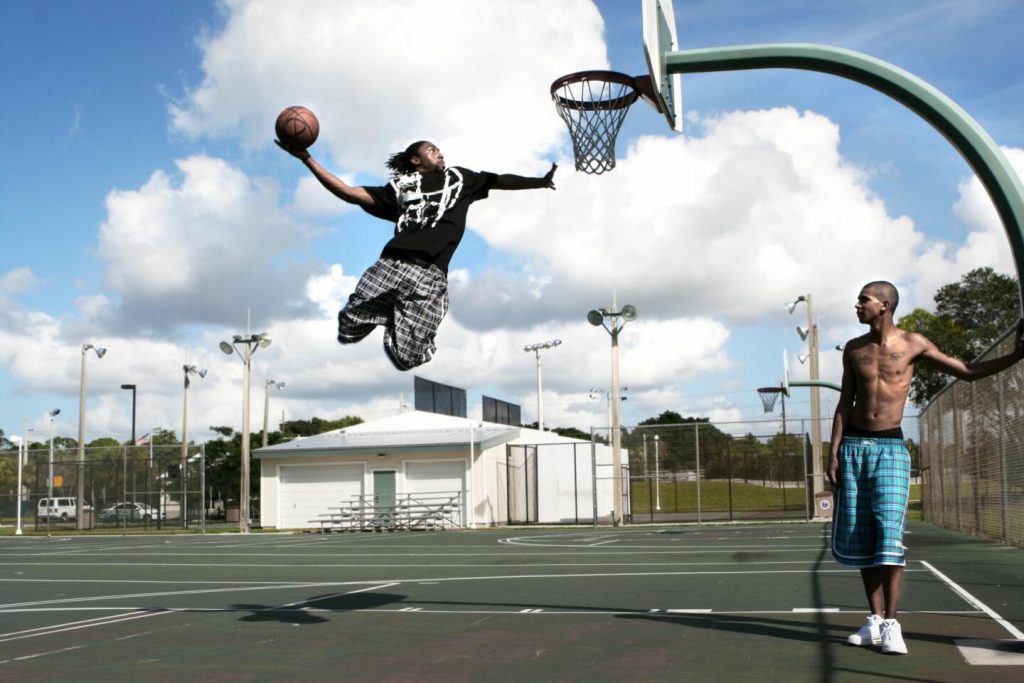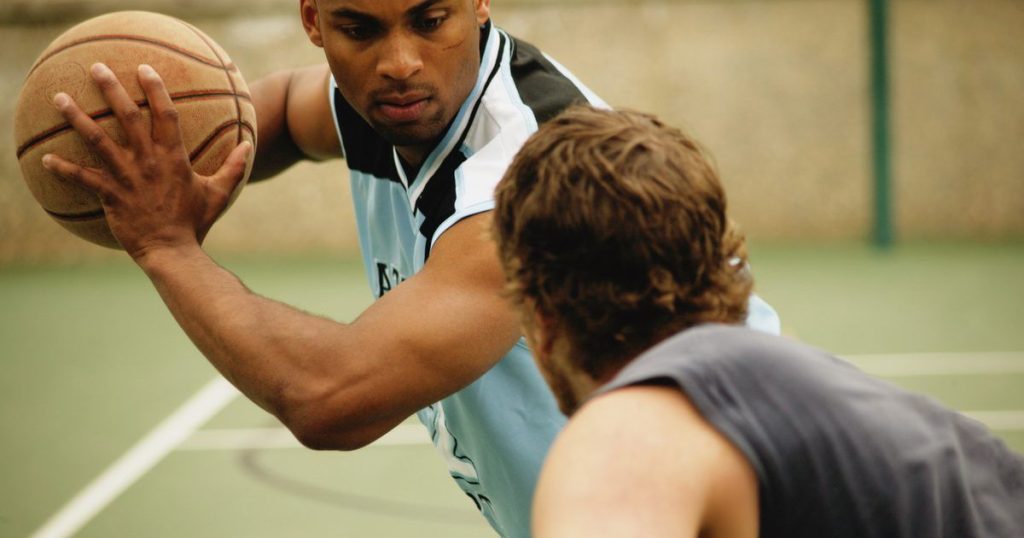3×3 basketball has long gone beyond street courts and is now officially recognized as a separate discipline at the global level. It made its debut at the Tokyo 2020 Olympic Games, became an integral part of the FIBA 3×3 World Tour calendar, and is actively developing in international player rankings. This game format is fundamentally different from traditional basketball: a smaller court size, incredible pace, unique possession structure, special tactics, and increased physical load create a truly unique spectacle. To fully understand what 3×3 basketball is, it is necessary to delve into its rules, training principles, equipment requirements, and strategic nuances. This is what we will discuss in the article.
What is 3×3 basketball: game features
The court layout is reduced by exactly half – 15×11 meters compared to the standard 28×15. The game is played on one basket, which increases intensity and minimizes pauses. A match consists of two teams: 3 active players plus 1 substitute, without a coach on the sideline, with full responsibility on the court.

The game lasts for 10 minutes of actual playing time or until one team reaches 21 points. Victory is awarded when the limit is reached before time or based on the total points at the end of the time. In case of a tie – overtime until a two-point difference.
The transition of the ball between possessions does not require an inbound pass: after a scored basket, the opponent must take the ball beyond the 2-point line (6.75m) and continue the attack without a timeout. This significantly speeds up the game and forces an instant switch from offense to defense.
What is 3×3 basketball from the perspective of street philosophy
 This format is based not on positional play, but on dynamics. Constant movement, isolations, quick pick-and-rolls, constant role switching between offense and support – each player must perform multiple functions. A playmaker cannot only be a conductor, and a center cannot only be a “tower.” Even a tall player over 200cm must be able to shoot from a distance, cover the arc, and defend against a speedy opponent.
This format is based not on positional play, but on dynamics. Constant movement, isolations, quick pick-and-rolls, constant role switching between offense and support – each player must perform multiple functions. A playmaker cannot only be a conductor, and a center cannot only be a “tower.” Even a tall player over 200cm must be able to shoot from a distance, cover the arc, and defend against a speedy opponent.
The philosophy of the game lies in instant reactions and physical audacity. Instead of long combinations – attacks on the first step. Instead of prolonged positional build-up – aggressive pressure. In 10 minutes, a player loses up to 1.5 liters of fluid and makes an average of 80 bursts and direction changes.
Ball possession rules: minimal tact, maximum rhythm
From the moment a team gains possession of the ball, they must attempt a shot at the basket within 12 seconds. For comparison: in traditional basketball, this limit is 24 seconds. This feature requires automatic decisions, well-thought-out combinations, and lightning-fast passing. Even a fraction of a second of hesitation turns into a loss.
After a defensive rebound or steal, the ball must also be taken beyond the arc. A player who fails to meet this condition loses the ball, and the attacking team receives a penalty. This creates an unprecedentedly high pace – an average of 15-18 attacks in 10 minutes, requiring explosive endurance from the athletes.
Winning strategies: rotations, screens, and isolations
What is 3×3 basketball: the strategy is built on three principles: minimizing turnovers, maintaining pace, and dominating in short series. Each play is like a separate game. Successful teams use:
- Isolations through hand-offs on the left flank, especially with a sharpshooter present.
- Screens with a kick-out to the corner, opening up a shot from behind the arc.
- Post-ups against a weak defender to draw a foul or easy points.
- Position inversion: the “small” player moves under the basket to shift the center to the arc and stretch the defense.
- Quick “give & go” on the return with a sharp cut to the basket.
Teams with synchronized ball movement not only get clean shots but also have the opportunity to control the rhythm. Rotations are almost absent because players have no time and no coach – adjustments have to be made during the game.
Equipment and gear: mobility and balance
The official ball for the 3×3 format is the Wilson FIBA 3×3 model. It has the diameter of a standard women’s ball (size 6) but the weight of a men’s ball (size 7). This increases maneuverability and control in limited space. Players can pass quicker and shoot more accurately while on the move.
Footwear should have minimal weight (up to 350 grams) and a sole with firm fixation to withstand constant turns, sprints, and falls. The compact shape of sneakers reduces the risk of ankle twists. Recommended models include Nike Zoom Freak 2, Adidas Harden Vol. 5, and Puma Fusion Nitro.
To understand what 3×3 basketball is, it is important to remember: to prevent microtraumas, compression sleeves, knee pads with shock-absorbing inserts, and gel inserts for the hips are used. Equipment is especially important on concrete or asphalt courts.
The difference between street and traditional basketball
3×3 basketball is not a simplified version of 5 on 5. It is a different sport, with its own logic, cadence, frames, and stars. There is no third chance here, no slow dribbling around the arc, and no safety nets.
Every turnover is an immediate response. Every ball touch is a responsibility. Here, systematic play does not win, but impulse does. Here, the champion is not necessarily a club but can be an individual who gathers a street team and wins the World Tour Challenger. This format has produced new stars: Stefan Stojakovic from Serbia, Karim Madjeri from Qatar, Liman 3×3, and Riga Ghetto have become professional brands.

Training in the 3×3 model:
- 10 minutes of running intervals in a 30/10 format (30 seconds sprint, 10 seconds recovery).
- A series of 100 shots from 5 points in 8 minutes.
- Work on rebounds in pairs: grabbing, taking the ball beyond the arc, instant passing.
- Simulation of a 2 on 2 game with a limit on touches – no more than 3 per attack.
- Final sparring up to 21 points with a fixed attack time – 12 seconds.
What is 3×3 basketball: conclusions
 This is a sport of a new generation. Compact, extremely energetic, unpredictable. It requires unconventional thinking, endurance, athleticism, and audacity in play. Here, it’s not about names but about instant decisions. This format has reignited the careers of dozens of players and paved the way into professional sports for those who didn’t make it in traditional basketball. Playing 3×3 correctly is a symphony of rhythm, aggression, and precision.
This is a sport of a new generation. Compact, extremely energetic, unpredictable. It requires unconventional thinking, endurance, athleticism, and audacity in play. Here, it’s not about names but about instant decisions. This format has reignited the careers of dozens of players and paved the way into professional sports for those who didn’t make it in traditional basketball. Playing 3×3 correctly is a symphony of rhythm, aggression, and precision.
 en
en  de
de  ar
ar  es
es  hi
hi  fr
fr  nl
nl  it
it  pt
pt  el
el 










